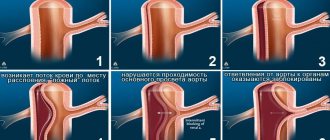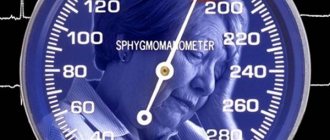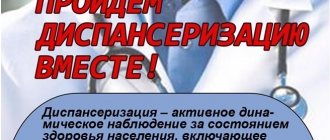Hypertensive crisis
is one of the most dangerous complications of arterial hypertension (hypertension).
It develops in approximately 15% of patients with arterial hypertension. The duration of a hypertensive crisis
can range from several hours to several days.
At the same time, the symptoms of existing hypertension intensify and become more pronounced. For every patient with hypertension
you should know about the likelihood of
a hypertensive crisis
, its signs and your actions in this condition.
Symptoms of hypertensive crisis
- A sharp increase in blood pressure to 220/120 mm Hg. Art. and higher.
- Headache, dizziness, tinnitus, black spots flashing before the eyes.
- Dyspnea.
- Nausea, vomiting.
- Chest pain.
- Neurological disorders (convulsions, impaired consciousness, paralysis).
A hypertensive crisis may be accompanied by a feeling of fear, trembling, chills, redness of the facial skin, swelling of the face, and blurred vision. Particular danger of hypertensive crisis
Represents for patients suffering from any diseases of the brain and heart.
How to get rid of nausea
If nausea is caused by high blood pressure, then measures should be taken to reduce it. To do this, you can use medications and folk remedies. The former should be used as prescribed by a doctor, with severe signs of hypertension. Folk remedies are suitable for eliminating minor deviations in pressure from the standard level.
To get rid of nausea against the background of high tonometer numbers, the following groups of drugs are suitable:
- diuretics;
- beta blockers;
- ACE inhibitors;
- antiemetics;
- antispasmodics.
Diuretics remove excess fluid from the body and reduce the load on the heart and blood vessels, normalizing well-being. They should be used in case of swelling. Among diuretics, doctors often prescribe for hypertensive patients: Furosemide, Torsid, Hypothiazide, Verapamil, Torsemide.
Beta blockers reduce blood pressure by slowing the heart rate and dilating blood vessels. They are advisable to use in cases where nausea occurs against the background of hypertension and tachycardia. Beta blockers include: Bisoprolol, Metoprolol.
ACE inhibitors help with hypertension by dilating the vascular lumen. They should be used to relieve nausea if the pressure has increased due to arteriolar spasm. Representatives of ACE inhibitors are: Captopril, Enalapril, Anaprilin.
If severe nausea or vomiting occurs, antiemetic medications should be used. These include: Metoclopramide, Motilac. To relieve an unpleasant symptom, these medications should be taken several times a day, half an hour before meals. The dosage is determined individually (approximately 1-2 tablets). If the pressure has increased against the background of arteriolar spasm, then an antispasmodic agent will help: No-shpa, Spazmalgon, Trigan-D.
If there is continuous vomiting, taking tablet medications is not justified. In this case, you must call an ambulance. Doctors will stop vomiting and lower blood pressure through intravenous injections.
Forms of hypertensive crisis
Cerebral angiohypotonic crisis with clinical manifestations of hypertensive encephalopathy
The most common form of hypertensive crisis. The reason is an excessive increase in cerebral blood flow and relaxation of cerebral vessels. The patient feels a pressing headache, a feeling of fear, dizziness, lethargy. Blood pressure may rise to 170/110 mmHg. This type of hypertensive crisis
often accompanied by vomiting.
Cerebral ischemic crisis
Less common form, but most dangerous. Blood pressure reaches higher numbers - 220/120 mmHg. The patient experiences general symptoms of cerebrovascular disease - dizziness, headache, neurological disorders - numbness of the face or limbs, impaired coordination of movements, short-term blindness or muteness. Cerebral ischemic crisis is a prerequisite for the development of cerebral stroke.
Hypertensive cardiac crisis
A hypertensive cardiac crisis by high blood pressure numbers. The patient experiences shortness of breath, chest pain, rapid heartbeat, and complains of a dry cough. Hypertensive cardiac crisis can cause myocardial infarction.
When vomiting is scary
Any attack of vomiting is a very unpleasant experience. Even if a person experiences relief with the resolution of the attack, the vomiting itself is perceived as an extraordinary event, which should not normally occur. Shock to the body, everyday and social inconveniences - all this makes vomiting a process of a different order compared to other reflex actions, such as coughing or sneezing. We always react sharply to vomiting (we don’t ignore it), and rightly so.
However, in some cases, vomiting worries us especially strongly. This is vomiting bile , vomiting blood . Parents are concerned about cases of vomiting in children . Quite often, vomiting is observed during pregnancy , attracting increased attention.
These cases are worth mentioning separately:
- Vomiting bile
Vomiting blood
Vomiting during pregnancy
Vomiting in a child
Complications of hypertensive crisis
A hypertensive crisis is dangerous not so much in itself as the influence of high blood pressure on target organs - in the first place. Disruption of blood microcirculation in the brain leads to swelling (hypertensive encephalopathy).
During an increase in blood pressure, the walls of the blood vessels in the brain experience enormous stress, which can lead to hemorrhage in the brain (hemorrhagic stroke).
A sharp increase in blood pressure also affects the function of the heart, not excluding the possibility of angina pectoris - an acute lack of blood supply to the heart muscle with the development of acute heart failure, expressed in the form of shortness of breath, suffocation, and pulmonary edema. The most severe complications of hypertensive crisis
are heart attack and stroke.
Vomiting and other symptoms
Vomiting is usually preceded by nausea, because, in essence, vomiting is the resolution of nausea, its logical conclusion. The fact that nausea turned into vomiting indicates the severity of the pathological process. Vomiting spasms can be observed against a background of elevated temperature, accompanied by diarrhea. In addition to food debris, gastric juice and mucus, vomit may contain bile, blood, and pus.
Repeated, periodically recurring and indomitable vomiting exhausts and dehydrates the body, leading to disruption of mineral metabolism and acid-base balance.
- Diarrhea and vomiting
Vomiting and fever
First pre-hospital emergency medical care for hypertensive crisis
Hypertensive crisis is a condition that requires urgent measures, because delay can lead to even more severe complications and death. The patient needs to clearly remember the simple rules of independent first aid and not get confused at the right moment.
Independent pre-medical emergency care primarily consists of taking the antihypertensive drugs used (Corinfar, captopril, nitroglycerin, furosemide, etc.) prescribed by the doctor.
During a hypertensive crisis, you need to try not to panic, relax and restore your breathing by taking a series of inhalations and exhalations several times. If an attack overtakes you at home, your loved ones can provide invaluable help: put mustard plasters on your calves, help you take warm foot baths (temperature 30-40 °C, duration of treatment - 10-15 minutes). The measures taken in no case cancel the call to the doctor, because only allow you to stop a hypertensive crisis
rather than eliminating its consequences.
It must be remembered that the main means of preventing hypertensive crises remains the main task - the treatment of arterial hypertension. Do not delay treatment for arterial hypertension
for tomorrow!
GUTA CLINIC specialists will individually select for you the most modern, effective, safe antihypertensive drugs in adequate dosage to achieve the best therapeutic effect, and will also prescribe a set of measures aimed at eliminating risk factors for high blood pressure.
Dizziness due to hypertension
Professor Olga Dmitrievna Ostroumova gave a lecture “Dizziness with arterial hypertension: is antihypertensive therapy sufficient?”
00:00
Drapkina Oksana Mikhailovna , executive director of the Internet Session, secretary of the interdepartmental council on therapy of the Russian Academy of Medical Sciences:
— Now we are moving on to a new, very interesting section “Dizziness in the practice of a therapist.”
Section consisting of one lecturer and discussion. Professor Ostroumova Olga Dmitrievna. The lecture is called “Dizziness with arterial hypertension: is antihypertensive therapy sufficient?”
Olga Dmitrievna Ostroumova , professor:
— Good afternoon, dear colleagues.
We will talk to you about dizziness. Dizziness is at least one of the most common complaints that patients present (if not the most common complaint).
If you look at any manuals on internal medicine (and not only internal medicine), the description of the clinical picture of almost every disease will contain dizziness. It turns out that the number of diseases that cause dizziness runs into the thousands, if not tens of thousands.
But dizziness is not always correctly diagnosed. It is very difficult to treat it. This is the kind of complaint that almost always remains the last. Other complaints are already going away, but the patient keeps complaining and complaining about dizziness. It feels like this is a saving straw.
Issues of polypharmacy. In order to relieve dizziness, doctors use many medications off-label. In general, the problem, at first glance, is simple, but it turns out to be very complex.
The main problem is that what the patient understands by dizziness, what the doctor understands by dizziness and the formal definition of dizziness are completely different things.
In fact, the patient uses the word “dizziness” most often where it does not exist. He has “lightheadedness”, weakness, darkening of the eyes, and a faint state. The complex of sensations preceding fainting is called the beautiful word “lipothymia”. This is either a decrease in cerebral blood flow or a change in the direction of reducing its supply of oxygen and glucose.
This happens with orthostatic hypotension, with hypoglycemia and a number of diseases of the cardiovascular system (CVS): aortic stenosis, sick sinus syndrome, tachyatrythmia.
02:41
By dizziness, the patient very often understands instability, unsteadiness. When walking, he staggers and throws, especially when turning, changing the pace of walking, or when initiating walking. In particular, this happens with damage to the cerebellum, with peripheral neuropathy, and with a number of diseases of the spinal cord.
Vague sensations that are difficult for the patient to describe: a feeling of heaviness, intoxication, discomfort inside the head. The patient also uses the word “dizziness” very often. In such a situation, most often we will talk about psychogenic dizziness (depression, phobia, anxiety). But not only this, of course. These are the most common options.
The first moment when the patient utters this word, you must try very carefully, with leading questions, to understand what complex of sensations is bothering him. Is it really dizziness?
True dizziness is the illusion of movement of surrounding people or objects around a person. Or, conversely, a person around people or objects. This is understood as true dizziness.
Accordingly, all diagnostic search algorithms, which are described in various manuals and monographs, relate to true dizziness. Once again, as taught in propaedeutics. Very thorough history taking. Try to understand, I emphasize again, with leading questions, what kind of complex of sensations the patient has, whether this is really true dizziness.
Believe me, most likely it will not be true dizziness. Further, based on the complex of sensations, the diagnostic search will go in completely different directions, completely inconsistent with the algorithm for true dizziness.
Our task is to talk about true vertigo. If this is really dizziness, if we completely simplify it without harming the patient, then we distinguish between vestibular dizziness (true, which is associated with the vestibular apparatus) and non-vestibular, that is, beyond it.
Vestibular vertigo. Vestibular apparatus. What is it, what are the options. The first is peripheral (damage to the labyrinth). The second is intermediate (vestibular nerve, transmission of impulses from receptors to the brain). Finally, the central one is where impulses about the position of our body in space come (this is the central nervous system).
05:54
Arterial hypertension is almost the most common complaint of dizziness among patients. Moreover, both before the start of antihypertensive therapy and during it. Including with formal stabilization of blood pressure, when we reach target numbers. It seems that this complaint haunts both patients and doctors.
If you look at whether these are really interconnected things, it turns out that, most likely, according to available data, arterial hypertension itself is not the cause of dizziness. We need to look for other reasons. For now, examine not the disease, but the patient, then treat.
We have already agreed that dizziness is a strictly defined thing - the illusion of the movement of objects around a person or, conversely, a person around objects or other people. The most common cause of true present dizziness in patients with arterial hypertension coincides with that in the population.
Relatively speaking, since hypertension occurs often in older people (more than 80%), the most common cause of true dizziness that exists in the population is involuntarily transferred to this population of patients with hypertension. This is benign paroxysmal positional vertigo. We will return to it later.
The most common cause of non-systemic (non-vestibular) dizziness is psychogenic dizziness. We will not comment on this.
Much more often, it is not hypertension that leads to dizziness, but, on the contrary, an excessive decrease in pressure. I would say, not even so much in terms of numbers (although this also occurs, they reduced the millimeters of mercury too much), but rather would focus your attention on the excessively rapid decrease in blood pressure. Pace, pace and more pace. Even in a state of hypertensive crisis.
Of course, if there is concomitant diabetes mellitus, this is hypoglycemia, rhythm and conduction disturbances, which are partly associated with hypertension, if there is myocardial hypertrophy. But very often with concomitant cardiovascular diseases (CVD) in the patient.
Of course, orthostatic reactions. They generally occur with arterial hypertension. But much more often in elderly hypertensive patients and when arterial hypertension is combined with diabetes mellitus. They happen without treatment. One of the features of hypertension in the elderly is an increase in orthostatic reactions.
Some antihypertensive drugs cause orthostatic hypotension and collapse as side effects. These are β-blockers. We rarely use these drugs to treat hypertension. But now these drugs are gaining popularity among urologists. Very often we began to encounter this indirectly.
09:29
In my opinion, extremely indicative and one of the fundamental works is the work carried out under the guidance of Professor V. A. Parfenov. This is a professor at the Department of Nervous Diseases of the First Moscow Medical University. The department is headed by Academician Yakhno. He deals with this problem a lot.
A very interesting, carefully executed study. 60 hypertensive patients were taken with a complaint of dizziness. The vast majority of situations (80%, four out of five patients) – nothing was found in the patients at all during the most thorough examination. There are no somatic or neurological disorders.
Thus, the first assumption that needs to be confirmed is psychogenic dizziness (anxiety, depression, phobias, and so on).
17% – diseases of the peripheral part of the vestibular apparatus (benign paroxysmal positional vertigo or vestibular neuronitis). We'll talk about it a little.
A most thorough examination revealed a tumor of the cerebellar angle in one patient, and migraine in one patient. One patient had AV block. He was given a pacemaker, after which the dizziness disappeared.
11:03
None of the patients showed a connection between dizziness and increased blood pressure.
Let’s just say a few words about this peripheral dizziness. True dizziness is a defeat of the labyrinth. Peripheral cause, vestibulatory apparatus.
There are also several reasons for dizziness. But we are internists, not specialists in ENT diseases and not neurologists. A few words about benign paroxysmal positional vertigo (the most common cause of dizziness, in the general population, or in a patient with arterial hypertension. After psychogenic).
How does this dizziness manifest itself? Survey, survey and survey again. I won’t tell you anything new since you completed the propaedeutics course. 50% of the success of a diagnosis is a correctly collected analysis and complaints.
Benign paroxysmal positional vertigo (BPPV) is a short, no more than a minute, attack of systemic vertigo that occurs only with a certain position of the head. Most often in a lying position.
A single attack or a series of attacks at the slightest movement of the head. When you interview, the patient paints approximately this picture for you. Despite the extreme lack of time, do not forget to ask leading questions.
There are no neurological or any other symptoms; with repeated provocation of attacks, their severity decreases.
The presence of freely moving particles in the semicircular canals is the most common cause of dizziness.
There are the simplest tests for diagnosing it, which every internist can master. Treatment consists of special exercises, the effectiveness of which is up to 90%. Usually, drug treatment is not even required.
How to be. Of course, the main treatment should be aimed at eliminating the causes that caused dizziness. Treatment of dizziness is a complex treatment. No matter how safe it may seem (when almost everyone has a symptom, it is involuntarily easy to relate to it), we know how difficult it is to treat. The drugs must be used as a complex.
13:59
We have the drug “Betahistine” - an analogue of histamine. Histamine receptors are found in different organs. I want to pay particular attention to the H3 receptors that have been found in the cerebral cortex of rats. Accordingly, high histamine levels cause negative feedback and decreased histamine release.
Histamine receptors are located not only in the central nervous system (CNS), but also in the vestibular apparatus. The vestibular nuclei are very rich in histamine receptors.
Histamine is a very effective remedy in the treatment of dizziness and Meniere's disease, for example. But it is administered intravenously. It has a number of side effects. I think you represent them perfectly. I won't repeat myself. It is obviously unrealistic to treat patients with dizziness with histamine.
The corresponding searches were underway. Betahistine was created. A major study has begun. The drug has been used for quite a long time.
How it affects different types of receptors. Basically, it acts on the third type of receptors (H3 receptors). A powerful antagonist. Doesn't work on H2 at all. On H1 it is a very weak agonist. This action can also be neglected.
This immediately results in a very good safety profile. Low incidence of side effects. It has no effect on other types of receptors (non-histamine).
The drug that I think you know, Betaserc, shows a complex mechanism of action. It improves regional blood flow in the inner ear area. Normalizes the excitation of peripheral receptors. Normalizes the process of excitation in the area of the vestibular nuclei of the brain stem. Quite a wide range of mechanisms of action.
16:10
Appropriate placebo-controlled studies were conducted, where it was shown that Betaserc was significantly different from placebo. It reduces the frequency of dizziness attacks. It also differs from placebo in reducing dizziness severity and duration.
I think that you all have your own experience with this drug. For the sake of order, we talked about how it differs from placebo. Patients of this kind are very susceptible to placebo effects. We have no doubt about the effectiveness of Betaserk.
Let me very briefly recall the indications: treatment and prevention of vestibular vertigo of various origins, as well as a syndrome including dizziness and headache, tinnitus, progressive hearing loss, nausea and vomiting, Meniere's disease and syndrome.
The only contraindication is hypersensitivity to any of the components of the drug.
Like the vast majority of drugs, Betaserc has a dose-dependent effect, including in the treatment of dizziness. The most effective dose is 48 mg/day.
The drug is very good for the speed of onset of effect. Maybe not completely until the dizziness completely disappears, but it is noticeable. Almost 80% (that's four out of five patients) feel either a complete disappearance of dizziness (depending on the severity) or a decrease in the severity and frequency of attacks. Almost everyone else feels the effect on the second or third day. It is extremely rare that the effect develops during the first week. Basically, the drug works on the first day or in the first days.
Recently a new dosage has appeared - 24 mg. Taken twice a day. There is no need to take the daily dose. The lower the frequency of administration, the better the patient’s adherence to therapy. Accordingly, the effectiveness of treatment is higher. There are economic benefits.
We weren’t lazy, we did the math. It turned out that the new dosage of 24 mg is 13% more economical than the dosage of 16 mg. In the old dosage of 8 mg, almost 50%.
The age-old and very difficult question: brand or generic. We will not go deeper into this painful topic. You understand that price should not come at the expense of quality.
In pharmacoeconomic studies there is such an indicator as “price-effectiveness” (the ratio of quality and price). Do we really gain something by paying less money? Or it will turn out to be “money down the drain.”
There was such a pharmacoeconomic study of a number of generics of the drug Betaserc. In short, the drugs Betaver, Vestibo, and so on have significant differences in clinical effectiveness.
Thus, in pharmacoeconomic terms, the drug “Betaserc” wins. It has proven to be most effective in relieving dizziness. There was better tolerance. Costs also indicate that among the three drugs studied, the original drug Betaserc turned out to be the most cost-effective due to its effectiveness. But, unfortunately, this is a very common reason.
This is what I wanted to discuss with you within the allotted time frame. I wish you to feel dizzy only from success.
20:29
How to get rid of nausea without medications
Acupressure massage is a good way to cope with mild nausea. Its essence is to influence certain acupuncture points for 5 minutes. In addition to nausea, acupressure stabilizes the psycho-emotional state and eliminates headaches.
Folk remedies involve the use of decoctions based on medicinal herbs. They have a soft effect. The advantage of non-traditional methods of getting rid of nausea is the minimal list of adverse reactions.
Healers give the following advice on getting rid of nausea due to hypertension:
- Make a decoction of lemon balm, chamomile or mint and drink it in small sips.
- Wash and chop the ivy leaves. Add a tablespoon of honey. Stir and eat without drinking water.
- Drink still mineral water in small portions.
- Brew green tea, add grated ginger root and drink.
- Grind 100 g cranberries and 200 g lingonberries. Pour boiling water over the berries and leave for a couple of hours. Pass through a sieve. Drink the finished product six times a day, a quarter glass.
The danger of intestinal coronavirus
This condition is dangerous not only because an inflammatory reaction develops, but also because during vomiting and diarrhea, the human body loses a large amount of fluid, which can result in dehydration (dehydration). Elderly people with additional chronic diseases are at particular risk. For them, this condition poses a threat not only to health, but also to life.
Diagnostics
By analogy with the respiratory form of coronavirus, diagnosis of the intestinal form of the disease is carried out using a laboratory PCR test. The nature of the patient's complaints is taken into account.
Condition Characteristics
From the moment the virus enters the body until the clinical symptoms of enteric coronavirus appear, 2 to 5 days pass. This condition does not occur in an asymptomatic form. Unlike the respiratory form, after a person has had an intestinal form of coronavirus, their body develops unstable immunity. The clinical picture of this condition is largely reminiscent of gastroenteritis.
In patients with chronic diseases of the gastrointestinal tract, the clinical symptoms of intestinal coronavirus are more pronounced.
Causes
Diarrhea due to coronavirus infection can be either primary or secondary. The primary variant of the disease develops from the direct effect of the virus on the body. When the virus is transmitted by the fecal-oral route, in the intestinal lumen the pathogenic microorganism attaches to the epithelial cells of the organ mucosa and provokes the development of the inflammatory process.
The secondary variant of the intestinal form of coronavirus is a complication that occurs after complex treatment of Covid-19. In 90% of cases, complex therapy for this infectious disease includes taking antibiotics, as this helps prevent the addition of a secondary bacterial infection. Antibiotics, in turn, have a detrimental effect not only on pathogens, but also on beneficial intestinal microflora. A person is faced with a phenomenon called dysbiosis.
Diagnostics
Patient examination
- Assessing the degree of dehydration.
- Determination of symptoms of acute surgical pathology.
- Neurological status, assessment of clarity of consciousness.
Recommended tests
- Blood tests (general, biochemistry, thyroid hormones, sugar levels).
- General urine test and pregnancy test.
- Stool analysis (coprogram, worm eggs, culture).
Recommended Research
- Ultrasound of the abdominal cavity and endoscopy.
- X-ray and colonoscopy.
- CT/MRI of the intestine, brain.







